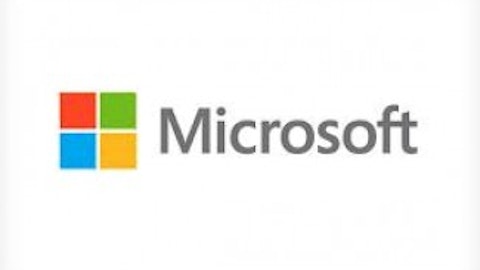
The opportunity
Microsoft has $74.5 billion in cash and investments, plus another $11.2 billion in equity investments in various companies, versus just $12 billion in debt. It could liquidate all its securities and pay off its debts seven times over. It’s the living, breathing definition of a safe, cheap stock. Interestingly, over the past decade, the share price of Mr. Softy has gone nowhere, lingering around the $30 threshold. But in the meantime, sales have more than quadrupled and cash flow jumped five fold. At today’s price, Microsoft Corporation (NASDAQ:MSFT) is a great buy for the following reasons:
- It has a fortress-like balance sheet. The company currently has $8.80 of cash per share. This means that a quarter of each share is pure cash. That’s a hefty margin of safety. And that’s one of the reasons that Microsoft received the triple-A rating that Moody’s stripped from the U.S. government.
- It’s virtually a monopoly in the software sector. Mr. Softy has a 90% market share in PC operating systems. This dominance is even greater than that of Cisco and Intel. Cisco controls 75% of the market for enterprise routers, which are used by large corporate clients, and it controls more than 65% of the Ethernet switch market. Intel, for example, has 80% of the global microprocessor market. This strong dominance leads to inherently high barriers to entry for newer rivals.
- Microsoft Corporation (NASDAQ:MSFT) is very cheap on an absolute level. It currently trades at a forward price-to-earnings of only 11.6. That’s way cheaper than the average P/E of 18 for the S&P 500. Another way to look at it is through its cash flow. At a current market cap of $300 billion, Microsoft is trading for only 10 times annual free cash flow. And for that price, you receive a company with a 35% operating margin.
How to take advantage of this opportunity
Investors can do one of two things — they can either buy the stock in the open market, or they can sell put options and pocket fat cash premiums on this trade. As of this writing, shares of Microsoft are trading at $35.70, and the January 2014, $36 strike puts are selling for $275. This translates into an immediate 7.3% gain on your investment by waiting six months until the January 2014 expiration.
To put it differently, investors can act as an insurance company and collect a premium of $275 for each option contract they sell. This contract, in turn, obligates them to buy shares of Microsoft Corporation (NASDAQ:MSFT) on the expiration day of January 2014 if shares are trading under $36. Repeat this trade two times a year, and, if conditions hold, you will make 15% annually, pre-tax.
How this plays out
There are three different scenarios that can happen on expiration day on January 2014:
- Share price of Microsoft> $36: You get to pocket the premium and have no obligations.
- Share price of Microsoft= $36: You get to pocket the premium and have no obligations.
- Share price of Microsoft< $36: You get to pocket the premium, but you will also be obligated to buy the shares at the predetermined price of $36. Since this is an excellent price to pay for the shares, you should be fine with that obligation.
Mr. Buffett is right beside you
The practice of selling put options on select stocks and indices has been mastered by Warren Buffett. Many investors may not know this but Berkshire Hathaway Inc. (NYSE:BRK.A) sells options, all the time. You see, it only makes sense for an insurance company to receive fat cash premiums for the obligation to purchase shares in the future for a predetermined price. For example, in the 2012 annual letter , Buffett stated that Berkshire sold long-term puts on four leading stock indices in the U.S., U.K., Europe, and Japan, for a total float premium of $4.2 billion. In addition, Berkshire earned in excess of $1 billion for writing puts on high-yield corporate bonds. Mr. Buffett states that:
“All told, these derivatives have provided a more-than-satisfactory result, especially considering the fact that we were guaranteeing corporate credits – mostly of the high-yield variety –throughout the financial panic and subsequent recession.”
It that context, it’s also worth noting that Mr. Buffett repeatedly stated in the past that Microsoft Corporation (NASDAQ:MSFT) is attractive but it’s “off bounds” for Berkshire because of Buffett’s long standing relationship with Bill Gates. If Buffett claims that a software company is attractive, you should pay close attention.
The Foolish takeaway
I recommend that you sell to open the Microsoft Corporation (NASDAQ:MSFT) January 2014 puts, at the $36 strike price, for no less than $250 per option contract.
The article An Opportunity to Make 15% a Year on Microsoft originally appeared on Fool.com.
Shmulik Karpf has no position in any stocks mentioned. The Motley Fool recommends Berkshire Hathaway Inc. (NYSE:BRK.A). The Motley Fool owns shares of Berkshire Hathaway Inc. (NYSE:BRK.A) and Microsoft Corporation (NASDAQ:MSFT). Shmulik is a member of The Motley Fool Blog Network — entries represent the personal opinion of the blogger and are not formally edited.
Copyright © 1995 – 2013 The Motley Fool, LLC. All rights reserved. The Motley Fool has a disclosure policy.





